Any good hunter takes the time to understand his or her prey. If you’re looking to win the battle against field mice and any other rodents, you should learn some of their habits.
Field mice typically stay not more than 30 feet from their food source. So if you want to eliminate these critters, it’s essential for you to gain a better understanding of their food habits. So what do field mice eat?
Let’s learn more about the staples of the field mouse diet.
The Regular Field Mouse Diet
The field mouse is a small mouse that commonly lives in fields just as its name suggests. It’s an independent mouse species but can nest colonially to improve its odds of surviving.
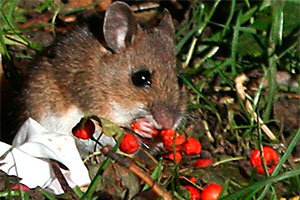 Its five top distinctive features are:
Its five top distinctive features are:
- large, protruding black eyes;
- large, sparsely furred ears;
- body fur that’s majorly dark brown and less uniform than that of a house mouse;
- white to grey underbelly;
- large back feet to provide an excellent spring for leaping.
The diet of field mice is mostly vegetarian. They often eat seeds, especially the pea and bean seeds. They’ll readily attack the seeds of newly planted legumes.
They also feed on the seed crops of trees such as beech, oak, lime, ash, sycamore, and hawthorn. They may also consume tubers, corms, and bulbs, especially those that have been planted recently.
The critters also love small fruits and berries.
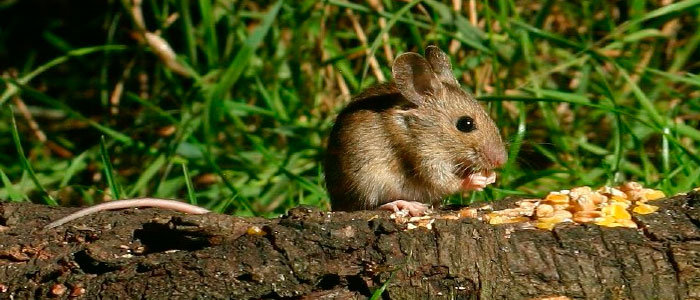
Other things that they can eat are:
- snails,
- insects,
- caterpillars,
- underground fungus.
Does the field mouse eat grass?
A hungry field mouse can feed on the seeds of grasses.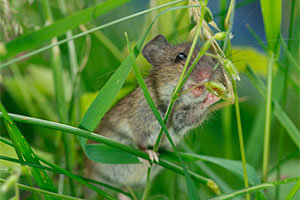 The mouse can also trample and eat grass as it makes runways through your lawn.
The mouse can also trample and eat grass as it makes runways through your lawn.
Besides the field mouse, there are many other different mouse species. Depending on climate and location, some are omnivores whereas others are strictly herbivores. So what do mice like to eat? Find out in this article.
The seasonal food habits
The field mouse is most active during the warmer seasons when more food is available within its environment. In late spring and early summer, it snacks on small snails and insects when seeds are hard to come by. It starts storing its food in caches in late summer and fall. It also gnaws on tree barks and eats animal remains.
During the winter, plant life is scarce. As a result, the rodent relies more heavily on roots, tree barks, and bulbs to meet its dietary needs. It often enters greenhouses where it carries off newly sown seeds from the seed trays. It can also enter sheds and eat stored fruits and vegetables.
Can they enter your home in search of food?
Field mice typically avoid humans, so it’s not easy to find them in your home. However, you may see them indoors when an infestation has progressed. Unlike house mice that tend to stay indoors, field mice will come in and exit through exterior openings. Occasionally, they can shelter themselves inside your walls.
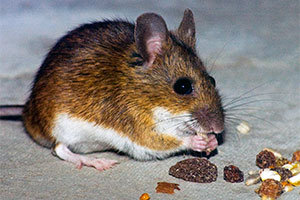 When they come into your home, these pests may be after your supply of grains or seeds. Water too may attract them indoors.
When they come into your home, these pests may be after your supply of grains or seeds. Water too may attract them indoors.
Water and food sources may attract mice to your home, so you may want to eliminate them in a bid to get rid of all the rodents in your home. But how long can mice live without food and water? Click this link to get the answer to this question.
You may even find these mice eating kitchen scraps from your garbage as well as dog and cat food. Field mice like feasting on bugs and other insects. Therefore, they may come in looking for insects, indicating your home has an insect problem.
What do wild field mice feed on?
In the wild, field mice are mostly nocturnal. They spend the day hiding in their burrows and usually look for food at night. They search for food by foraging. A significant part of their waking activity time is spent visiting the feeding sites within their territory that they’re most familiar with. These cautious rodents will always sniff things they’re unfamiliar with before approaching them.
Wild field mice are commonly found in grasslands, forests, and fields that have plenty of food.
Do they feed on acorns?
 Wild field mice often consume plant materials such as acorns.
Wild field mice often consume plant materials such as acorns.
Here are some other materials that they feast on:
- blueberries,
- pecans,
- cherries,
- grapes,
- strawberries,
- violets,
- hickory nuts,
- beechnuts.
Other plants
The majority of the wild field mouse diet consists of seeds. The most common seeds they consume are those from oaks, sycamores, ashes, and hawthorns. They also consume maple seeds, pine seeds, poplar seeds, and black cherry tree seedlings. They usually store seeds in their burrows for consumption over the winter months.
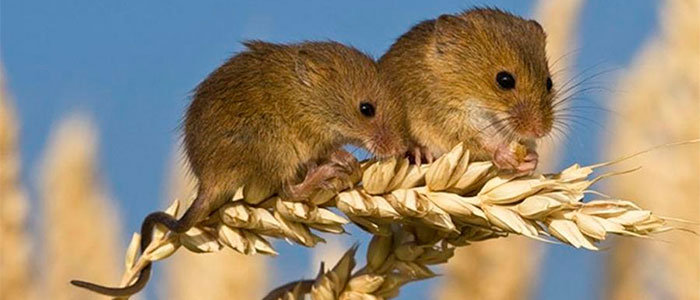
These critters also feed on root plants like carrots and potatoes as well as mushrooms. When they raid gardens, they can take a bite or two out of the vegetables such as corn, peas, bell peppers, beans, and radishes.
Wild field mice will also feed on any of the following:
- tomatoes,
- tulip bulbs,
- peanut butter,
- oats,
- apple and pear tree barks,
- wheat,
- olive and corn oil,
- peaches,
- peppers.
What about insects?
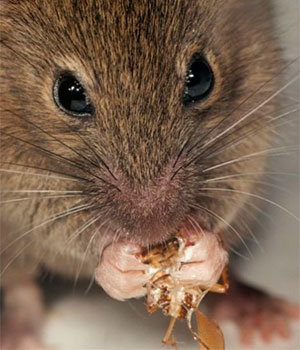 Field mice also feed on insects such as grasshoppers, spiders, moths, and caterpillars. They also eat the insect larvae that they find burrowed into the ground. They mostly do this during the winter when berries and seeds are scarce.
Field mice also feed on insects such as grasshoppers, spiders, moths, and caterpillars. They also eat the insect larvae that they find burrowed into the ground. They mostly do this during the winter when berries and seeds are scarce.
You now have a good idea of what wild field mice eat. But do you know the animals that find these mice to be pretty tasty?
In the wild, field mice make burrows to protect themselves from predators. They’re also experts in camouflage, which is their biological response to being prey to many animals. Owls, hawks, cats, dogs, snakes, rabbits, wolves, and bears are some of their natural predators.
Animals
Wild mice eat a variety of small invertebrates such as:
- snails,
- slugs,
- centipedes,
- earthworms.
The digestive systems of these wild mice are incredibly strong, so they can feed on carrion, which would sicken many other animals.
Field mice can steal and eat bird eggs from nests when seeds and nuts become less available. When they’re desperate, they can eat their fellow mice.
Pros and Cons of the Field Mouse’s Eating Habits
The feeding habits of field mice can be both beneficial and destructive.
- They often eat seeds of trees, helping gardeners in the process by preventing the appearance of huge numbers of unwanted seedlings.
- Field mice can also keep pesky insects in check, becoming of benefit to any crops you’re growing.
- Due to their love for seeds, berries, and fruits, field mice can enter storage facilities and cause costly damage. When they enter greenhouses during the winter, they can destroy a significant number of seedlings overnight.
- Field mice feed on tree barks, especially in the colder seasons. They leave rings of bare wood around the trunks of trees and shrubs. When they girdle or strip the barks of fruit trees, they bring about economic losses.
- Field mice frequently eat from planted crop fields and gardens. When they regularly eat the leaves and roots of plants, they adversely affect the plants by inhibiting their growth. Sometimes they bite off strawberries and other fruits before they’re ripe and leave them in small heaps along other plants. A huge field mouse infestation can drastically reduce the harvest of your farm or garden.
- As you already know, these rodents store food in their burrows to last the cold winter months. The shallow runways they create will crisscross your yard haphazardly and remain hidden by snow. You’ll only see the unsightly mess they’ve made out of your yard when the warmer weather arrives.
How to get rid of field mice? Click here to find out.
With the knowledge you’ve gained on what field mice like to eat, it’s now easier to remove these annoying rodents from your private property. You can work towards blocking access to or eliminating the food sources that are attracting the critters to your property. But that’s not all. You could use the food to bait mouse traps.
Traps are helpful in capturing pesky rodents. You can enhance their efficiency by using bait. Learn more about the best mouse bait to use here.
